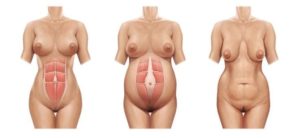Pregnancy can be a life-changing experience for women, but some of the changes the body goes through during pregnancy can remain even after birth. Many women find that they’re left with a post-pregnancy pooch that won’t go away, even with a healthy diet or targeted exercises. But just what causes that tummy paunch or post-pregnancy pooch in the first place?
1. Subcutaneous Fat Deposits
Subcutaneous fat is located just below the skin while visceral fat lies deeper within the body. The post-pregnancy pooch you can pinch between your fingers is subcutaneous fat, which is notoriously difficult to get rid of with lifestyle changes alone. A shift in hormone levels makes it easy to gain weight during pregnancy, but losing the belly fat afterward can be a different story.
2. Stretched-Out Skin
Abdominal skin stretches during pregnancy and doesn’t always shrink back to its former size later on. The number of pregnancies as well as the quality of your skin plays a role in how resilient your skin is to these changes. Many women find that after giving birth, they’re left with a stretched-out tummy that prevents them from feeling confident about their midsection.
3. Separated Abdominal Muscles
Pregnancy can put considerable pressure on the stomach muscles and can sometimes cause them to weaken and separate. This condition is known as diastasis recti, and often results in a distended stomach. While mild diastasis recti can be corrected without surgery, many cases are impossible to resolve with surgical intervention.
A tummy tuck, or abdominoplasty, can resolve all of these concerns. A popular choice for women post-pregnancy, a tummy tuck can restore the stomach to its pre-baby contours. This procedure removes loose, excess skin, repairs abdominal muscles and gets rid of diet and exercise resistant abdominal fat for a fitter looking result.

